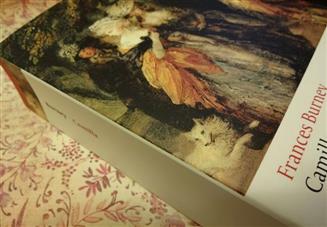A Proposal for a paper to be Delivered at a meeting of the Burney Society in Montreal 2014, prelude to JASNA AGM
Frances's Fanny: A proposed solution

It's long been, and still is, a contentious issue whether to refer to Frances Burney d'Arblay as Frances Burney (D'Arblay) or Fanny Burney. Recent work in Burney studies by Lorna Clark, Geoffrey Sills, Clare Harman and Ingrid Tieken Boonvan has demonstrated the value of taking into account that, like much life-writing, the specific matter of Burney's journals, diaries, letters, all her life-writing frequently includes much semi- and extensive fictionalizing. I will argue Frances performed a character in an on-going novel first for the benefit of herself, Susan Burney Phillips, and her second father, Mr Crisp; and as these deeply congenial interlocutors were taken by death, for herself, her husband, her other sisters, friends and father. She rewrote and added to it over the years, and after the publication by her great-great niece of her diaries and journals (6 volumes, 1842) set up as a multiple volume novel, the character she partly invented so endeared herself to her audience, she came to be identified with as the chief character of Evelina (the one book that remained read by general readers at the end of the century) who was seen as autobiographical.
I aim to do more than reconcile the two positions. There is the question of how conscious Burney was of the blindnesses, misapprehensions, and stubborn refusals to acknowledge realities in front of her heroine, which went counter to Burney's deepest needs and wishes. One instance is the long narrative of her husband's death. When we read the narrative as by an author who is co-terminus with her character, we may feel that by Fanny's insistence on refusing to acknowledge that her husband was hopelessly terminally ill and that he was dying, our heroine made his agonized ordeal harder for him. The implication is that the author writing this narrative does not see what she shows us is the truth: that the man was dying and that even when he is a corpse, is treated by her as someone she can still nurse and cover for warmth, as someone not yet dead (Wiltshire). The reality of such a tragically ironic text is that if the author did not put into her narrative the apprehension that the man was dying, we could not see it. In hindsight as the author revised later she perhaps saw or acknowledged what was happening, or perhaps she at the time saw what was happening really and could not get herself openly to cope with it. In either case, by discussing the text as dramatizing Fanny performing blindness because she cannot bear to acknowledge the truth at the same time as her author contextualizes the scenes with the truth, we do more than give Burney credit due her: we explain the dual vision of the text. We can extend this kind of double or ironic reading to many of the famous conundrums of her life-writing. Since we see the opaqueness of George Cambridge's approach to Fanny but she does not, does that mean that Frances Burney d'Ablay writing and then rewriting these passages years later does not? She must see it even if Fanny believes the man about to propose and then hindered by a published paragraph about them, or the text could not be read as opaque. A puzzling diary whose literal realities we have been trying to reach (and cannot) becomes a sophisticated ironic autobiographical text.
I propose to analyze sections from the life-writing to suggest how differently and now fruitfully in new directions we can read her life-writing texts. What kinds of ironies does she aim at her heroine in the early as opposed to the middle or later years? Do her patterns of imaginative invention alter? How? It would now not be a question of the relation of the text to “life,” but what is the nature of the truth this complex sophisticated 24 plus volume epistolary autobiography produces. How does Burney fit in with other women who voluminous powerful life-writing, from Lillian Hellman. Doris Lessing and Muriel Spark who published memoirs to the more closely analogous work of Virginia Woolf and contemporary and 19th century women diary-keepers. The Victorian way of reading Burney's diaries (Civale) began a tradition of seeing the character in the diaries and the author as the same presence; they are not.
Select Bibliography
- Civale, Susan. The Literary Afterlife of Frances Burney and the Victorian Periodical Press, Victorian Periodicals Review, 44:3 (2011):236-66.
- Clark, Lorna J. Dating the Undated: Layers of Narrative in Frances Burney's Court Journals, Life-Writing Annual, 3 (2012):121-42.
- Wiltshire, John. Love unto Death: Fanny Burney 'Narrative of the Last Illness and Death of General D'Arblay (1820), Literature and Medicine, 12:2 (1993):215-34.
Home
Contact Ellen Moody.
Pagemaster: he has died, is no more
Page Last Updated 14 February 2014